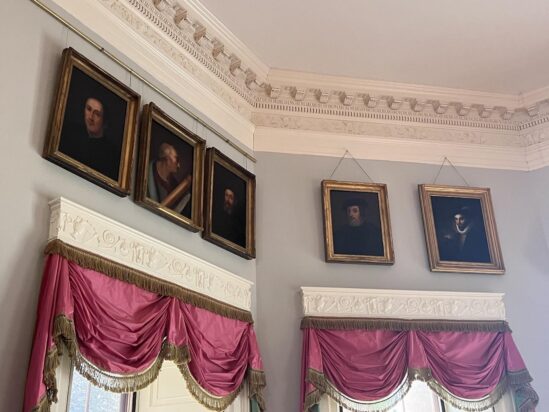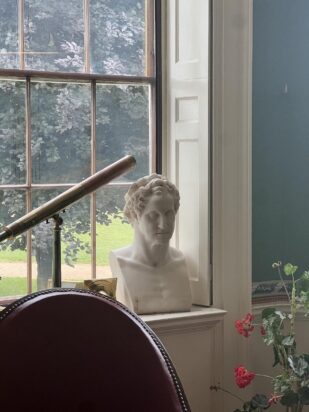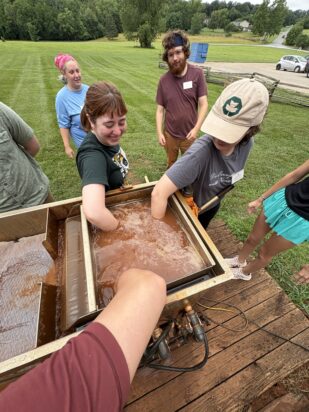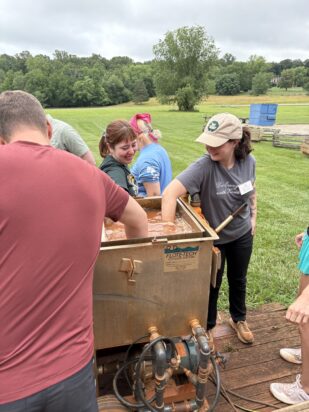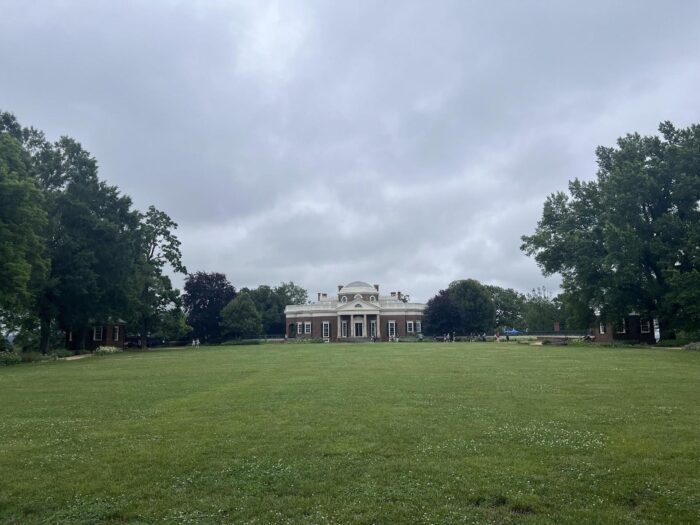Archaeology Blog
2025 Field School Week 3
By: Matthew Marsden & Wallace Payne
Week 3 at the 2025 Poplar Forest Field School is complete, with a whole host of experiences to reflect on. From touring Monticello, Thomas Jefferson’s home in Charlottesville Virginia, to continued excavations across the property, us field school students have been able to take what we have learned from lectures and readings and apply them to multiple sites in central Virginia.
We started this week with a field trip to Monticello. As Thomas Jefferson’s home rather than a retreat, it gives off an air of grandeur not entirely felt at Poplar Forest. At Monticello, Jefferson commonly hosted influential individuals within political and economic spheres, along with large gatherings. At Poplar Forest, Jefferson’s visitors tended to be friends and family. The size of the houses reflects this, with Poplar Forest being smaller than Monticello. The placement of the houses on their respective properties is reflective of Jefferson’s intentions, as well. Monticello sits atop its own mountain, with the property lines extending to a higher peak near the house. From Monticello, the Blue Ridge is easily seen. The main house at Poplar Forest, however, sits on level ground, surrounded by trees and flanked by earthen mounds. Although Jefferson’s retreat home at Poplar Forest is an architectural work of art and stands out among other homes at the time, Monticello is a beautiful structure, combining American, British, French, and Italian influence to create something wholly unique. Of course, it has its similarities to Poplar Forest. The octagonal base is shared among both homes. Jefferson was inspired by naturalistic designs later in life, incorporating special varieties of trees, plants, and earthen structures to achieve a desired landscape outcome. Various architectural and landscape designs at Monticello can be seen at Poplar Forest. For instance, although both Monticello and Poplar Forest were inspired by aspects of Italian architect Andrea Palladio’s designs, each house uses architecture and landscape elements slightly different. At Monticello, architectural wings branching from the north and south sides of the house connect it to iceboxes, storage areas, and kitchens. At Poplar Forest, they exist in spirit, with rows of trees and earthworks branching from the east and west sides of the house. Monticello is a more elaborate building, inside and out. Despite this, Jefferson’s style comes through at both locations. It seems though Jefferson’s intentions in building a retreat from public life were successful, as he fled Monticello for Poplar Forest during the American Revolution and later decided to build a retreat house on the property.
Despite being a retreat, Poplar Forest was well-connected to Monticello. Putting Jefferson’s personal travel aside, the transportation of goods and people from one location to another is well-observed in historical documentation from Jefferson’s letters. Even today, archaeological information is shared between sites. As our field school toured the house and grounds, we had the opportunity to connect with field school students working at Monticello. As we discuss the research on the lives of enslaved persons at Jefferson’s properties, we gain a better understanding of how his influence was felt across the region. Their discoveries, techniques, and interpretations showed us that despite our work occurring dozens of miles apart, the work being done is attempting to tell the story of one of America’s earliest presidents, the people who labored for him, and their impact on central Virginia.
Back at Poplar Forest, we’ve resumed digging at both the Quarter Site and 1857 Slave Dwelling, as well as starting to use a flotation machine. At the Quarter Site, we’ve opened three new 5×5’ units. In these new units, we hope to find remains of a garden outside the houses, as well as some of the fence lines. So far, we have found a lot of charcoal flecking, which is likely evidence of previous plant remains. We have also found a large number of cobbles in some of the units, which is possibly indicative of a path or road documented in the 20th century aerial photographs.
At the 1857 Slave Dwelling, we found many of the same types of artifacts we have been finding so far this summer. There were some really interesting ceramics, mostly different kinds of whiteware. There’s been a lot of ironstone in particular found this week. Ironstone is easily identified because of the cracking or crazing patterns we often find on them. This type of ceramic was popularized in the 1800s, particularly in the 1850s and later. We also learned how to use flotation technology at our lab this week. Flotation is used on soil samples we collect so we can look at smaller artifacts, charcoals, and plant remains. Plant remains like pollen are surprisingly useful pieces of information; they allow archeologists to see what kind of environmental factors may have been around in specific years. Monticello also uses a lot of pollen sampling, and we sat in on one of their lectures about it while visiting this week.
